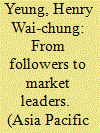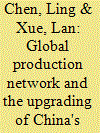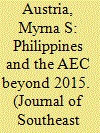| Srl | Item |
| 1 |
ID:
076392


|
|
|
|
|
| Publication |
2007.
|
| Summary/Abstract |
It has become conventional wisdom in management literature that family-owned business is restricted by its management practices and, therefore, cannot grow beyond a certain size. In the case of Chinese family firms, these practices are related to paternalism, nepotism, personalism, and fragmentation. This paper examines three detailed qualitative case studies of Chinese family firms from Hong Kong that have relentlessly pursued growth through internationalization. It argues that venturing into foreign markets and transnational operations has become an effective means for Chinese family firms to expand beyond the limits of domestic markets and centripetal management structures. International business strategies enable Chinese family firms to socialize trusted members into the corporate "family," provide a training ground for the future heir to the patriarch, and consolidate networks of personal and business relationships. There are, therefore, no a priori reasons to support the alleged limits to the growth of Chinese family firms in their international context.
|
|
|
|
|
|
|
|
|
|
|
|
|
|
|
|
| 2 |
ID:
099913


|
|
|
|
|
| Publication |
2010.
|
| Summary/Abstract |
Using an analytical framework of the global production network (GPN), the present paper examines the external environment and the internal dynamics of China s integrated circuit (IC) industry. We analyze the transition of China s IC industry from a state-led integrated device manufacturers' model to deeper integration into the GPN. We also explore the technological sources, the upgrading dynamics as well as the positioning of different nodes of China s IC industry in the GPN. We conclude that the "East Asia model" of gradual industrial upgrading might not apply anymore in the new era of GPN. High-technology industries can now be upgraded based on a parallel evolution model. Policy implications for China's high-technology industrial upgrading strategies are drawn from our analysis.
|
|
|
|
|
|
|
|
|
|
|
|
|
|
|
|
| 3 |
ID:
140005


|
|
|
|
|
| Summary/Abstract |
As the deadline for the ASEAN Economic Community (AEC) approaches, the Philippines has yet to complete the implementation of its commitments in the AEC Blueprint. While it is true that the government has implemented most of them, these policy reforms have yet to make an impact on the economy. This paper examines the country’s performance in terms of its commitments in the AEC by identifying the gaps between those commitments and actual implementation. It also examines the domestic economic conflicts that have hampered Philippine policy reform efforts, focusing on the automobile industry. The conflicts may be due to a lack of common economic interests among firms in the industry as well as because of the lack of coherence of domestic policies that have limited, if not negated, progress towards economic integration. Domestic conflicts have created an industry that has failed to develop as a major exporter as well as a source of employment and income for the country.
|
|
|
|
|
|
|
|
|
|
|
|
|
|
|
|